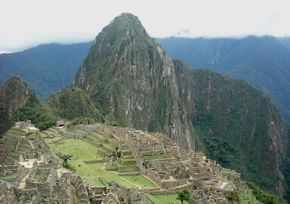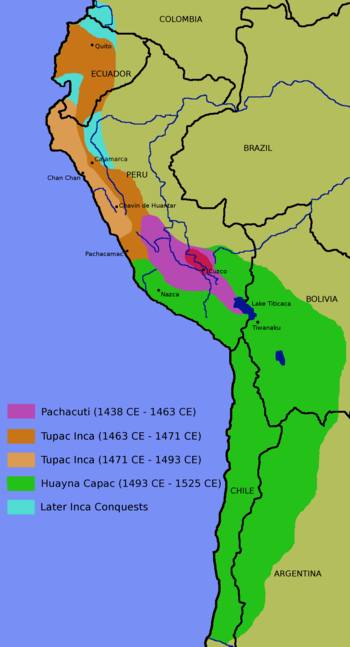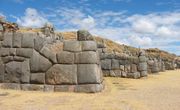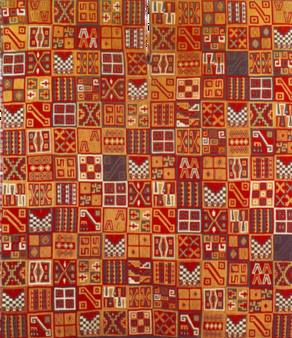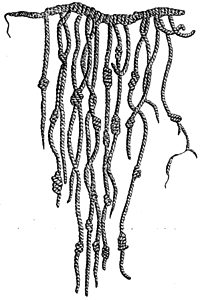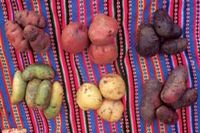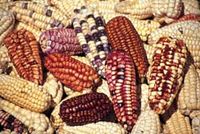|
INCAS
|
||||||||||
|
HOME | BIOLOGY | FILMS | GEOGRAPHY | HISTORY | INDEX | MUSIC | THE BOAT | SOLAR BOATS |
||||||||||
|
The Inca Empire (Tawantin Suyu in Quechua modern orthography, or Tahuantinsuyo in Hispanicized Quechua orthography; The Four United Regions), was an empire centered in what is now Peru from AD 1438 to AD 1533. Over that period, the Inca used conquest and peaceful assimilation to incorporate in their empire a large portion of western South America, centred on the Andean mountain ranges. The Inca empire proved short-lived: by AD 1533, Atahualpa, the last Inca emperor, called a Sapa Inca, was killed on the orders of the conquistador Francisco Pizarro, marking the beginning of Spanish rule.
Incas Machu Picchu
Tawantinsuyu, the indigenous name of the empire, derives from the Quechua "tawa" (four) , to which the suffix "-ntin" (together or united) is added, followed by "suyu" (region or province), which roughly renders as "The land of the four parts together". The empire was divided into four suyus, whose corners - according to Inca mythology - met at the "Navel of the World" (Qosqo), where their capital Cusco was located, now in modern-day Peru.
The official language of the empire was Quechua, although over seven hundred local languages were spoken. The Inca leadership encouraged the worship of their gods, the foremost of which was Inti, the sun god.
Origin stories
The Inca had two origin myths. In one, Tici Viracocha of Colina de las Ventanas in Pacaritambo sent forth his four sons and four daughters to establish a village. Along the way, Sinchi Roca was born to Manco and Ocllo, and Sinchi Roca is the person who finally led them to the valley of Cuzco where they founded their new village. There Manco became their leader and became known as Manco Capac.
In the other origin myth, the sun god Inti ordered Manco Capac and Mama Ocllo to emerge from the depths of Lake Titicaca and found the city of Cuzco. They traveled by means of underground caves until reaching Cuzco where they established Hurin Cuzco, or the first dynasty of the Kingdom of Cuzco.
The knowledge of these myths is due to oral tradition, since the Incas did not have writing. There probably did exist a Manco Capac who became the leader of his tribe. The archeological evidence seems to indicate that the Inca were a relatively unimportant tribe until the time of Sinchi Roca, also called Cinchi Roca, who is the first figure in Inca mythology whose existence can be supported historically.
Inca expansion (1438-1527 AD)
Emergence and expansion
The Inca people began as a tribe in the Cuzco area around the 12th century AD. Under the leadership of Manco Capac, they formed the small city-state of Cuzco (Quechua Qosqo), shown in red on the map.
In 1438 AD, under the command of Sapa Inca (paramount leader) Pachacuti, whose name literally meant "world-shaker", they began a far-reaching expansion. The land Pachacuti conquered was about the size of the Thirteen Colonies of the United States in 1776, and consisted of nearly the entire Andes mountain range.
Pachacuti reorganized the kingdom of Cuzco into an empire, the Tahuantinsuyu, a federalist system which consisted of a central government with the Inca at its head and four provincial governments with strong leaders: Chinchasuyu (NW), Antisuyu (NE), Contisuyu (SW), and Collasuyu (SE). Pachacuti is also thought to have built Machu Picchu, either as a family home or as a Camp David-like retreat.
Pachacuti would send spies to regions he wanted in his empire who would report back on their political organization, military might and wealth. He would then send messages to the leaders of these lands extolling the benefits of joining his empire, offering them presents of luxury goods such as high quality textiles, and promising that they would be materially richer as subject rulers of the Inca. Most accepted the rule of the Inca as a fait accompli and acquiesced peacefully. The ruler's children would then be brought to Cuzco to be taught about Inca administration systems, then return to rule their native lands. This allowed the Inca to indoctrinate the former ruler's children into the Inca nobility, and, with luck, marry their daughters into families at various corners of the empire.
It was traditional for the Inca's son to lead the army; Pachacuti's son Túpac Inca began conquests to the north in 1463, and continued them as Inca after Pachucuti's death in 1471. His most important conquest was the Kingdom of Chimor, the Inca's only serious rival for the coast of Peru. Túpac Inca's empire stretched north into modern day Ecuador and Colombia.
Túpac Inca's son Huayna Cápac added significant territory to the south. At its height, Tahuantinsuyu included Peru and Bolivia, most of what is now Ecuador, a large portion of modern-day Chile, and extended into corners of Argentina and Colombia.
Tahuantinsuyu was a patchwork of languages, cultures and peoples. The components of the empire were not all uniformly loyal, nor were the local cultures all fully integrated. For instance, the Chimú used money in their commerce, while the Inca empire as a whole had an economy based on exchange and taxation of luxury goods and labour (it is said that Inca tax collectors would take the head lice of the lame and old as a symbolic tribute). The portions of the Chachapoya that had been conquered were almost openly hostile to the Inca, and the Inca nobles rejected an offer of refuge in their kingdom after their troubles with the Spanish.
Spanish conquest and Vilcabamba
Spanish conquistadors led by Francisco Pizarro explored south from Panama, reaching Inca territory by 1526. It was clear that they had reached a wealthy land with prospects of great treasure, and after one more expedition (1529), Pizarro travelled to Spain and received royal approval to conquer the region and be its viceroy.
At the time they returned to Peru, in 1532, a war of succession between Huayna Capac's sons Huascar and Atahualpa and unrest among newly-conquered territories-- and perhaps more importantly, smallpox, which had spread from Central America-- had considerably weakened the empire.
Pizarro did not have a formidable force; with just 180 men, 1 cannon and only 27 horses, he often needed to talk his way out of potential confrontations that could have easily wiped out his party. Their first engagement was the battle of Puná, near present-day Guayaquil, Ecuador; Pizarro then founded the city of Piura in July 1532. Hernando de Soto was sent inland to explore the interior, and returned with an invitation to meet the Inca, Atahualpa, who had defeated his brother in the civil war and was resting at Cajamarca with his army of 80,000 troops.
Pizarro met with the Inca, who had brought only a small retinue, and through interpreters demanded that he convert to Christianity. Atahualpa was handed a Bible and threw it on the floor, which the Spanish interpreted as adequate reason for war, though some chroniclers suggest that Atahualpa simply didn't understand the notion of a book. The Spanish attacked the Inca's retinue (see Battle of Cajamarca), capturing Atahualpa.
Atahualpa offered the Spaniards enough gold to fill the room he was imprisoned in, and twice that amount of silver. The Incas fulfilled this ransom, but Pizarro refused to release the Inca. During Atahualpa's imprisonment Huascar was assassinated. The Spanish maintained that this was at Atahualpa's orders; this was one of the charges used against Atahualpa when the Spanish finally decided to put him to death, in August 1533.
The Spanish installed his brother Manco Inca Yupanqui in power; for some time Manco cooperated with the Spanish, while the Spanish fought to put down resistance in the north. Meanwhile an associate of Pizarro's, Diego de Almagro, attempted to claim Cusco for himself. Manco tried to use this intra-Spanish feud to his advantage, recapturing Cusco (1536), but the Spanish retook the city.
Manco Inca then retreated to the mountains of Vilcabamba, where he and his successors ruled for another 36 years, sometimes raiding the Spanish or inciting revolts against them. In 1572 the last Inca stronghold was discovered, and the last ruler, Túpac Amaru, Manco's son, was captured and executed, bringing the Inca empire to an end.
Flag of the Tawantinsuyu
After the Spanish conquest
After the fall of Tahuantinsuyu, the new Spanish rulers brutally repressed the people and their traditions. Many aspects of Inca culture were systematically destroyed, including their sophisticated farming system. The Spanish used the Inca mita (mandatory public service) system to literally work the people to death. One member of each family was forced to work in the gold and silver mines, the foremost of which was the titanic silver mine at Potosí. When one family member died, which would usually happen within a year or two, the family would be required to send a replacement.
The major languages of the empire, Quechua and Aymara, were employed by the Catholic Church to evangelize in the Andean region. In some cases, these languages were taught to peoples who had originally spoken other indigenous languages. Today, Quechua and Aymara remain the most widespread Amerindian languages.
The legend of the Inca has served as inspiration for resistance movements in the region. These include the 1780 rebellion led by Tupac Amaru II against the Spanish, as well as contemporary the guerrilla movementpac Amaru Revolutionary Movement (MRTA) and Sendero Luminoso in Peru and Tupamaros in Uruguay.
Tawantinsuyu has a modern rainbow flag which is displayed throughout Peru.
Society
Political organization of the empire
The most powerful figure in the empire was the Sapa Inca ('the unique Inca'). When a new ruler was chosen, his subjects would build his family a new royal dwelling. The former royal dwelling would remain the dwelling of the former Inca's family. Only descendants of the original Inca tribe ever ascended to the level of Inca. Most young members of the Inca's family attended Yachayhuasis (houses of knowledge) to obtain their education.
The Tahuantinsuyu was a federalist system which consisted of a central government with the Inca at its head and four provinces: Chinchaysuyu (NW), Antisuyu (NE), Qontisuyu (SW), and Qollasuyu (SE). The four corners of these provinces met at the center, Cuzco. Each province had a governor who oversaw local officials, who in turn supervised agriculturally-productive river valleys, cities and mines. There were separate chains of command for both the military and religious institutions, which created a system of partial checks and balances on power. The local officials were responsible for settling disputes and keeping track of each family's contribution to the mita (mandatory public service).
The four provincial governors were called apos. The next rank down, the tukuyrikuq (local leaders), numbered about 90 in total and typically managed a city and its hinterlands. Below them were four levels of administration:
Every five waranqa curaca, pachaka curaca, and chunka kamayuq had an intermediary to the next level called, respectively, picqa waranqa curaca, picqa pacaka curaca, and picqa conka kamayoq. This means that the middle managers managed either two or five people, while the conka kamayoq (at the worker manager level) and the apos and t'oqrikoq (in upper management) each had about 20 people reporting to them.
The descendants of the original Inca tribe were not numerous enough to administer their empire without help. To cope with the need for leadership at all levels the Inca established a civil service system. Boys at age of 13 and girls at age of first menstruation had their intelligence tested by the local Inca officials. If they failed, their ayllu (extended family group) would teach them one of many trades, such as farming, gold working, weaving, or military skills. If they passed the test, they were sent to Cuzco to attend school to become administrators. There they learned to read the quipu (knotted cord records) and were taught Inca iconography, leadership skills, religion, and, most importantly, mathematics. The graduates of this school constituted the nobility and were expected to marry within that nobility.
While some workers were held in great esteem, such as royal goldsmiths and weavers, they could never themselves enter the ruling classes. The best they could hope for was that their children might pass the exam as adolescents to enter the civil service. Although workers were considered the lowest social class, they were entitled to a modicum of what today we call due process, and all classes were equally subject to the rule of law. For example, if a worker was accused of stealing and the charges were proven false, the local official could be punished for not doing his job properly.
Arts
The Inca were a conquering society, and their expansionist assimilation of other cultures is evident in their artistic style. The artistic style of the Inca utilized the vocabulary of many regions and cultures, but incorporated these themes into a standardized imperial style that could easily be replicated and spread throughout the empire. The simple abstract geometric forms and highly stylized animal representation in ceramics, wood carvings, textiles and metalwork were all part of the Inca culture. The motifs were not as revivalist as previous empires. No motifs of other societies were directly used with the exception of Huari and Tiwanaku arts.
Incan construction at Sacsayhuamán
Architecture
Architecture was by far the most important of the Inca arts, with pottery and textiles reflecting motifs that were at their height in architecture. The stone temples constructed by the Inca used a mortarless construction process first used on a large scale by the Tiwanaku. The Inca imported the stoneworkers of the Tiwanaku region to Cusco when they conquered the lands south of Lake Titicaca. The rocks used in construction were sculpted to fit together exactly by repeatedly lowering a rock onto another and carving away any sections on the lower rock where the dust was compressed. The tight fit and the concavity on the lower rocks made them extraordinarily stable in the frequent earthquakes that strike the area. The Inca used straight walls except on important religious sites and constructed whole towns at once.
The Inca also sculpted the natural surroundings themselves. One could easily think that a rock along an Inca trail is completely natural, except if one sees it at the right time of year when the sun casts a stunning shadow, betraying its synthetic form. The Inca rope bridges were also used to transport messages and materials by Chasqui running messengers. The Inca also adopted the terraced agriculture that the previous Huari civilization had popularized. But they did not use the terraces solely for food production. At the Inca tambo, or inn, at Ollantaytambo there is evidence that the terraces were planted with flowers.
The terraces of Moray are a spectacular example of Incan terracing. It has been suggested that they were used to develop new strains of crops as large temperature diferentials between the top and bottom terraces have been observed, or they may have been purely decorative.
The Inca provincial thrones were often carved into natural outcroppings, and there were over 360 natural springs in the areas surrounding Cusco, such as the one at Tambo Machay. At Tambo Machay the natural rock was sculpted and stonework was added, creating alcoves and directing the water into fountains. These pseudo-natural carvings functioned to show both the Inca's respect for nature and their command over it.
Inca tunic
Clothing
Inca officials wore stylized tunics that indicated their status. The tunic displayed here is the highest status tunic known to exist today. It contains an amalgamation of motifs used in the tunics of particular officeholders. For instance, the black and white checkerboard pattern topped with a red triangle is believed to have been worn by soldiers of the Inca army. Some of the motifs make reference to earlier cultures, such as the stepped diamonds of the Huari and the three step stairstep motif of the Moche. In this royal tunic, no two squares are exactly the same.
Cloth was divided into three classes. Awaska was used for household use, having an approximate threadcount of about 120 threads per inch. Finer cloth, qunpi, was divided into two classes: The first, woven by male qunpikamayuq (keepers of fine cloth), was collected as tribute from throughout the country and was used for trade, to adorn rulers and to be given as gifts to political allies and subjects to cement loyalty. The other class of qunpi ranked highest. It was woven by aqlla (female virgins of the sun god temple) and used solely for royal and religious use. These had threadcounts of 600 or more per inch, unsurpassed anywhere in the world, until the Industrial Revolution of the 19th century.
Aside from the tunic, a person of importance wore a llawt'u, a series of cords wrapped around the head. To establish his importance, the Inca Atahualpa commissioned a llawt'u woven from vampire bat hair. The leader of each ayllu, or extended family, had its own headdress.
In conquered regions, traditional clothing continued to be worn, but the finest weavers, such as those of Chan Chan, were transferred to Cusco and kept there to weave qunpi. (The Chimú had previously transferred these same weavers to Chan Chan from Sican.)
The wearing of jewellery was not uniform throughout the empire. Chimú artisans, for example, continued to wear earrings after their integration into the empire, but in many other regions, only local leaders wore them.
Ceramics and metalwork
Ceramics were for the most part utilitarian in nature, but also incorporated the imperialist style that was prevalent in the Inca textiles and metalwork. In addition, the Inca played drums and on woodwind instruments including flutes, pan-pipes and trumpets made of shell and ceramics.
The Inca made beautiful objects of gold. But precious metals were in much shorter supply than in earlier Peruvian cultures. The Inca metalworking style draws much of its inspiration from Chimú art and in fact the best metal workers of Chan Chan were transferred to Cusco when the Kingdom of Chimor was incorporated into the empire. Unlike the Chimú, the Inca do not seem to have regarded metals to be as precious as fine cloth. When the Spanish first encountered the Inca they were offered gifts of qunpi cloth.
Representation of an Incan Quipu
Education
The Inca used quipu, knotted cords, for accounting and census purposes. Most of the information on the quipus has been shown to be numeric data; some numbers seem to have been used as mnemonic labels, and the color, spacing, and structure of the quipu carried information as well. Since it isn't known how to interpret the coded or non-numeric data, some scholars still hope to find that the quipu recorded language.
The Inca depended largely on oral transmission as a means of maintaining the preservation of their culture. Inca education was divided into two distinct categories: vocational education for common Inca and highly formalized training for the nobility.
Religion
The Incan religion was polytheistic (sun god, earth goddess, corn god, etc.). Subjects of the empire were allowed to worship their ancestral gods as long as they accepted the supremacy of Inti, the sun god, which was the most important god worshipped by the Inca leadership. Consequently, ayllus (extended families) and city-states integrated into the empire were able to continue to worship their ancestral gods, though with reduced status.
Much of the contact between the upper and lower classes was religious in nature and consisted of intricate ceremonies that sometimes lasted from sunrise to sunset.
Medicine
The Inca made many discoveries in medicine. They performed successful skull surgery, which involved cutting holes in the skull to release pressure from head wounds. Coca leaves were used to lessen hunger and pain, as they still are in the Andes. The Chasqui (messengers) chewed coca leaves for extra energy to carry on their tasks as runners delivering messages throughout the empire. Recent research by Erasmus University and Medical Center workers Sewbalak and Van Der Wijk showed that, contrary to popular belief, the Inca people were not addicted to coca. Another remedy was to cover boiled bark from a pepper tree and place it over a wound while still warm. The Inca also used guinea pigs not only for food but for a so-called well-working medicine.
Burial practices
The Inca believed in reincarnation. Those who obeyed the Incan moral code — ama suwa, ama llulla, ama quella (do not steal, do not lie, do not be lazy) — went to live in the Sun's warmth. Others spent their eternal days in the cold earth.
The Inca also believed in mummifying prominent personages. The mummies would be provided with an assortment of objects which were to be taken into the pacarina. Upon reaching the pacarina, the mummies or mallqui would be able to converse with the area's other ancient ancestors, the huacas. The mallquis were also used in various rituals or celebrations. The deceased were generally buried in a sitting position. One such example was the 500-year-old mummy "Juanita the Ice Maiden", a girl very well-preserved in ice that was discovered at 20,000 feet, near the summit of Mt. Ampato in Southern Peru. Her burial included many items left as offerings to the Inca gods.
Other practices
The Inca practiced cranial deformation. They achieved this by wrapping tight cloth straps around the heads of newborns in order to alter the shape of their still-soft skulls. These deformations did not result in brain damage. Researchers from The Field Museum believe that the practice was used to mark different ethnicities across the Inca Empire.[1]
Around 200 varieties of Peruvian potatoes were cultivated by the Incas and their predecessors
Food and farming
It is estimated that the Inca cultivated around seventy crop species. The main crops were potatoes, sweet potatoes, maize, chili peppers, cotton, tomatoes, peanuts, an edible root called oca, and grains known as quinoa and amaranth. The many important crops developed by the Inca and preceding cultures makes South America one of the historic centers of crop diversity (along with the Middle East, India, Mesoamerica, Ethiopia, and the Far East). Many of these crops were widely distributed by the Spanish and are now important crops worldwide.
The Inca cultivated food crops on dry Pacific coastlines, high on the slopes of the Andes, and in the lowland Amazon rainforest. In mountainous Andean environments, they made extensive use of terraced fields which not only allowed them to put to use the mineral-rich mountain soil which other peoples left fallow, but also took advantage of micro-climates conducive to a variety of crops being cultivated throughout the year. Agricultural tools consisted mostly of simple digging sticks.
The Inca also raised llamas and alpacas for their wool and meat and to use them as pack animals, and captured wild vicuñas for their fine hair.
The Inca road system was key to farming success as it allowed distribution of foodstuffs over long distances. The Inca also constructed vast storehouses, which allowed them to live through El Niño years in style while neighboring civilizations suffered.
Inca leaders kept records of what each ayllu in the empire produced, but did not tax them on their production. They instead used the mita for the support of the empire.
The Inca diet consisted primarily of fish and vegetables, supplemented less frequently with the meat of cuyes (guinea pigs) and camelids. In addition, they hunted various animals for meat, skins and feathers. Maize was used to make chicha, a fermented beverage.
References in popular culture
Notes
References
Peruvian maize (corn) were well-known to the Incas for centuries
LINKS:
GENERAL HISTORY LINKS
MARITIME HISTORY
A taste for adventure
Solar Cola - a healthier alternative
|
||||||||||
|
This website is Copyright © 1999 & 2007 NJK. The bird logo and name Solar Navigator and Solar Cola are trademarks. All rights reserved. All other trademarks are hereby acknowledged. Max Energy Limited is an educational charity. |
||||||||||
